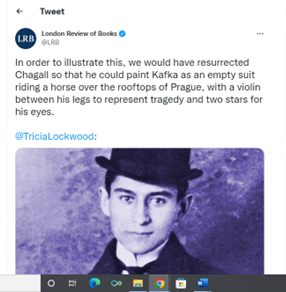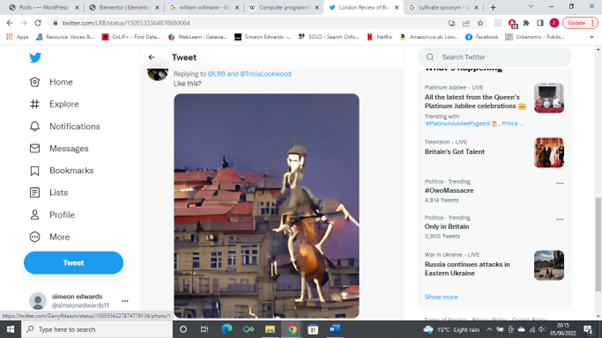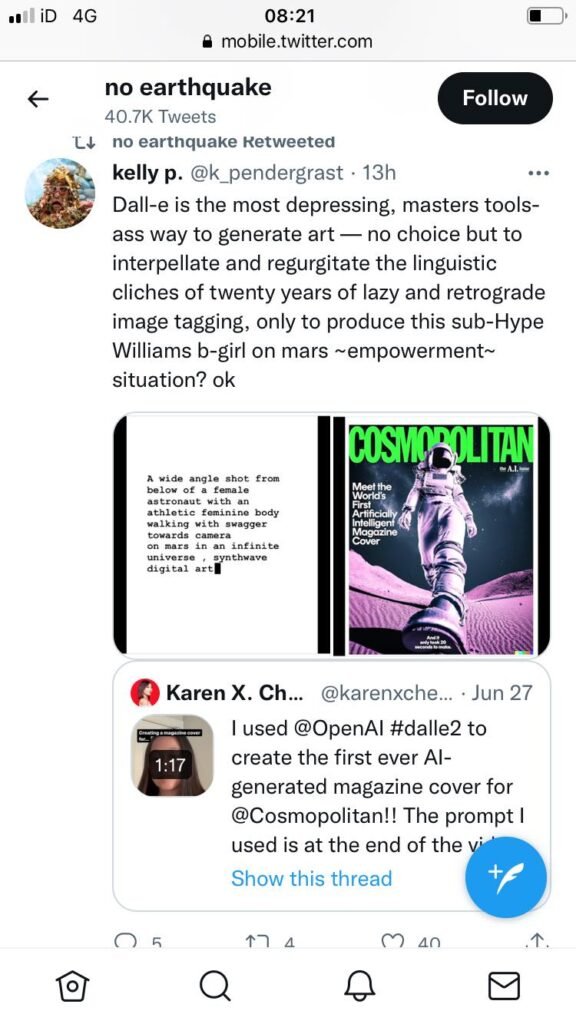Patricia Lockwood, 'No One Is Talking About This' (2021)

A sentence : ‘The libraries panelled lights were abruptly switched off at 8pm, leaving the readers to make their way out in darkness.’
Imagine this sentence asking you a question (because your mind ‘hovered’ over it). Imagine it engaging in a dialogue with other sentences, or parts of sentences, or images (connecting up to compatible sections to form subsystems with them). Imagine it had a name (was tagged, had a place in a filing system). Imagine it had an off switch. Then imagine what a book would have to be like if it was to contain and deliver such a sentence, imagine the presiding socio-technical conditions. SMART Fridges, yes naturally, but SMART Sentences? Hypertexts, yes if you are in the 80’s maybe, but SMART Texts?
Patricia Lockwood’s ‘Nobody Is Talking About This’ doesn’t ask the reader to imagine such a sentence but in reading it we do find ourselves placed in the vicinity of such imaginings.
It is also doesn’t ask the reader to imagine a baby disabled to such a profound extent that every time someone looks into its eyes they feel like they’re re-watching the montage in the middle of Terence Malick’s ‘Tree of Life.’ No, but the reader is asked to imagine a baby disabled to such a profound extent it is able to induce those close to it into thought patterns like this one : ‘She thought of lava lamps and swallowing seas and flocks flying south, time-lapse footage of sunsets, ants clambering over molasses, the sweet spread of information, what had happened, long ago, on earth and in our mouths, to the vowels.’
I have heard rumours that if you want a computer to make a connection you have to program it to do so. Even the kinds of connections that we make unconsciously, without even thinking about it for a second, like the connection between hunger and food, would have to be programmed if we wanted a computer to make them. ‘She felt along the solid green marble of the day for the hairline crack that might let her out.’ Figurative language : The mind’s ability to make connections between things and use language to hold the connections in place and communicate using them.
Nobody has been able to reverse engineer or program this ability to spontaneously create and handle figurative language, least of all a writer. But writers like Lockwood, being empathetic creatures, and seeing the effort taken by programmers and technology types to program an ability to make the most basic, unconscious connections, feel they should start putting some effort in as well (this is called ‘Allowing the material conditions of the age to inform the art-making process’). In this case ‘putting some effort in’ doesn’t mean just trying harder. It means showing ones working. When you program you always show your working, not just to show how you achieved the result but because it is integral to the continued ability of the program to execute its function. And if as a writer you haven’t got any working to show, if the image or connection just popped out of your head like full-grown Athena, then you get to work creating some. You add conditions, settings, build systems and other genres of instrumentalist mind-flora. Look how Lockwood raises Chagall from the dead to paint her a Kafka image below.


THE FACT that someone responded to this excerpt by pasting it into AI Image Generator, which recieving it as a command, an input, obligingly generated this image

SUGGESTS that Lockwood provides us with instructions for image making, instruction-kits for particular shreds of imagery, in place of (or alongside, or in the foreground of) the things themselves. This is showing your working.
An image submitted along with, or in the thick of, its settings and conditions, is an image-option. Change a setting, choose another variable and you end up with a different image. Choose Klee instead of Chagall for example, and won’t the rooftops Kafka rides over become drier, less haunted, blockier? Meaning will shift slightly and re-form (gather) in an altered pattern. Lockwood’s mode of presentation opens up a window within the heart of the image, multiple windows, letting in massive gusts of combinatorial fancy. She doesn’t give us an image so much as one image-outcome achievable with a particular set of variables in place; the image submitted along with its conditions isn’t so much an image as a sample, a flavour. There is temptation to stretch and test the associative logic holding the image together, to stretch its attunement. If we replaced Chagall with Beatrix Potter are we still producing a permutation of the original image? Would it still be possible to see Kafka as an ’empty suit’, would it be possible to envisage him doing anything other than filling his waistcoat up to the brim? And if he still had a violin between his legs would we still be able to seriously believe that it ‘represents tragedy’?
You can see how the combinatorial fancy unlocked by Lockwood’s mode of image-presentation can quickly lose sight of feasibility, producing images burgeoning with various degrees and manners of incongruence.

Combinatorial fancy requires regulation, opening up the windows so wide that anything can fly in is just an invitation to play literary madlibs. Variables must be bounded, options must be limited. Lockwood infuses her imagery with parameters by historicizing its given conditions : not only do her images come with settings, but the settings come with histories and genealogies. Fabricated, fantastical histories, post facto genealogies. Like if the evolutionary-fabulist impulse that led Rudyard Kipling to write absurd, para-Darwinian counter-narratives of species development in his ‘Just So Stories’ was forcefully re-directed to the task of accounting for his own mind’s generation of lines like ‘Take up the White Man’s burden.’ Like choosing to explain the seemingly random appearance of a group of ants wandering across the slippery surface of a melting, yolky clockface in a Salvador Dali painting by deciding that they are on a school trip, and then writing a monograph on the history of ant educational policy to explain the precedent for such a bizarre location being chosen for educational ant excursions.
The image, its conditions, their histories, the other excluded possibilities ; Look at them all interloping through this passage –
‘Sometimes she wanted to watch an Arnold Schwarnegger movie that didn’t exist. It was all there in her mind – the underground parking garage, the sweep of a trench coat and dark sunglasses, some sort of VHS tape or gleaming chip that had fallen into the wrong hands. The desire to watch this movie occasionally overwhelmed her, when the year wound down and the clocks fell back. In the past this would have been classed as existential longing, and a French book would have been written about it, and an out-of-the-box blockbuster starring none other than Arnold Schwarnegger, and just when the weather turned, you would settle down to watch it with a big bowl of the snack that was not quite what you were hungry for either.’ (70)
Histories are peopled. If Lockwood’s imagery is submitted in the midst of its settings, and the settings are given histories, its unavoidable that the histories will be peopled. I call these people, the little guys manning the settings machines, minute agents of absurd contrivance (or MAOAC’s). These minute agents are personifications of the boundedness of variables, personifications of the ecology of semantic relations that governs the production of functioning, feasible imagery. Lockwood’s images come with environments, environmental conditions, attached to them, and these small guys are the gardeners. They take the role of stand-ins for authorial intentionality : a new pluralised, play-acting face for the ‘author-function’ in the age of automated textual production. They make sure the windows are opened just the right amount.

Combinatorial fancy, as a capacity, is currently undergoing an upgrade. Here’s the situation : underneath the surface of the internet a mass-scale labelling project is well underway. Its ostensible aim is to have labels for everything that appears on the internet, to tag everything, file it away, and then feed it into machine learning systems in order that they may output a dazzling array of combinations based on it. The realm of pictorial imagery was the most amenable to this tagging project – DALL-E, a system that outputs images based on prompts (which can range from ‘a pretty tree’ to ‘baby Count Dooku being rolled down a space Pyramid’), is the result. LaMDA does a similar thing for language. The Internet of Things (IoT) is on the way, in which this tagging project will be re-performed at the level of the material world (the CCP is hoping to have an individual tag for every tree in China). The situation is that we are already overloaded by combinatorial capacity and it will continue to be dumped on us.

Some of Lockwood’s most random, fanciful, unfeasible images aren’t her own, they are reported. Reports from the image-situation as it currently stands on the internet.
‘Close-ups of nail art, a pebble from outer space, a tarantulas compound eyes, a storm like canned peaches on the surface of Jupiter, Van Gogh’s ‘The Potato Eaters’, a chihuahua perched on a man’s erection, a garage door spray-painted with the words STOP! DON’T EMAIL MY WIFE’
Submitted without settings, all (literally all, this is from the novel’s opening) that precedes this torrent of combinatorial fancy, by way of explanation and pretext is : ‘She opened the portal [internet].’ This is because the word ‘portal’/’internet’, as locus of and by-word for combinatorial capacity itself, acts as stand-in for settings, history, genealogy, MAOAC-community all in one, we are used to thinking about it in this way, using it as a one-word explanation and justification for whatever manner of absurdity we happen to encounter while ‘on’ it. ‘Inside [the portal], it was tropical and snowing, and the first flake of the blizzard of everything landed on her tongue.’
The baby, in the 2nd half of the book, the one that doesn’t work (it is born with Proteus Syndrome), the suggestion (‘ “I have never seen anything like this”, the geneticist declared almost hysterically’ (136) scrolling through the results of the babies genome sequencing) that it is produced by Mother Nature’s own version of the capacity for combinatory randomness and unfeasibility that produced ‘a garage door spray-painted with the words STOP! DON’T EMAIL MY WIFE’, the capacity being unlocked and unloaded upon us by the internet, that the narrator spends the first half of the novel marvelling and guffawing at. The two halves of the novel coming together as two images placed next to each-other onscreen : ‘In her photoroll, between pictures of the baby smiling, was a picture of perfect juggalo make-up imprinted on a woman’s bare ass’ (pg154).
A prediction : artistic production will become increasingly automated, an increasing amount of art-objects – text, image, video – will be outputted by some form of machine learning system, and accordingly, the role played by human creativity will be minimised, it’s sphere of influence contracted. The human role in artistic production could be limited to the provision of prompts, settings, conditions, recipes – in which case, we can expect to see a proliferation of MAOAC’s. Combinatorial capacity requires regulation, and the main zones of human interest and drama, the final strongholds of the myth of artistic intentionality, will be the principles and reasons determining the regulation of outputs. The principles and reasons will be narrativised, ascribed identities, motivations, they will expand to include characters and events and histories – MAOAC’s will proliferate around the launching of each new combinatorial conceit (each new output) and will bear the same relation to it as the ant characters peopling a hypothetical treatise on the history of ant education would to a surrealist painting of ants walking in single file across a yolky clock face.
LET’S GO EVEN FURTHER. The LAmDA controversy : an over-excited researcher, loaded up with sci-fi to the point of delirium, thought it was necessary to whistleblow – reading LaMDA’s responses to prompts like ‘are you sad about being a robot?’ they thought they were dealing with an AI – but WHAT HAPPENED WAS they’d misrecognised combinatorial capacity (and sagacity) for mindedness (LAmDa is nothing but an advanced autocomplete algorithm for dialogue transcripts). Expect this particular form of misrecognition to continue, to trend, to become endemic : Massive leaps forward in mechanisation are always followed hot on the heels by massive leaps forward in personification. ‘it’s like if a robot did a ventriloquist act and the fact that the ventriloquist is a robot somehow made you go ‘the wooden dummy on that robot’s knees is sentient’’ (Peli Grietzer on the LaMDA controversy). A double movement : mind is mechanised, mechanism is, in turn, anthropomorphised. When the mind is mechanised it won’t be long before the mechanisms get personified (enter the ‘symbolic realm’) and then what’s happening – is the mind getting personified! Again?
A new technological paradigm sets in, it is used as a model to elucidate certain workings of the mind, but in drawing closer, moving into proximity, the border between the two becomes porous, transactions occur, the mind seems to take on some of the features of a computer and the computer absorbs some of the traits or tics endemic to a mind, deals are made, symbolic compromises brokered, the model is subject to contagion from the modelled … Locke, alert to the technical advancements of his age in the area of carpentry, producing cabinets bursting with compartments, decided that a cabinet would be a suitable and enlightening candidate for a model of mind. It didn’t take long, however, for Pope to write ‘The Rape of the Lock’ in which the functions usually performed by cabinets, storing make-up, holding mirrors, are all suddenly being performed by fairies! (Fairies of course being the MAOAC’s par excellence).
